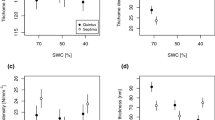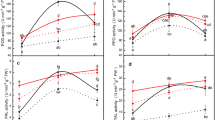Abstract
Although aphids are among the most injurious of all agronomic insect pests, much remains unknown about how their feeding alters plant physiology. Two experiments were conducted to examine the physiological responses of wheat, Triticum aestivum L. and barley, Hordeum vulgare L. to injury by Diuraphis noxia (Mordvilko) and Rhopalosiphum padi (L.) (Hemiptera: Aphididae). Gas-exchange parameters, chlorophyll fluorescence, and chlorophyll content were examined at 3, 6, and 9 days post-infestation on control and aphid (D. noxia and R. padi) infested treatments. In general, chlorophyll content and chlorophyll fluorescence parameters (non-variable minimal fluorescence, maximal fluorescence, and variable fluorescence) were not significantly affected by either aphid species. Photochemical and non-photochemical quenching coefficients were significantly impacted by both aphid species, suggesting that aphid feeding may influence the photoprotective xanthophyll cycle altering the thylakoid membrane pH gradient. Feeding by both aphid species resulted in an increase in electron transport rate, but at different time periods. Wheat plants infested with D. noxia had accelerated declines in photosynthetic capacity when compared to R. padi-infested and control plants. These plants exhibited decreased values for Amax, which was accompanied by decreased values for Vcmax and Jmax Neither aphid species negatively affected the photosynthetic capacity of the barley plants until day 9. At this time, aphid-infested plants had decreased values for Amax which was accompanied by decreased values in Jmax. Although R. padi feeding does not typically result in visual damage symptoms as previously demonstrated, clearly this aphid does have an impact on the gas-exchange and chlorophyll fluorescence of its host plants.




Similar content being viewed by others

References
Burd JD, Elliott NC (1996) Changes in chlorophyll a fluorescence induction kinetics in cereals infested with Russian wheat aphid. J Econ Entomol 89:1332–1337
Farquhar GD, Sharkey TD (1982) Stomatal conductance and photosynthesis. Annu Rev Plant Physiol 33:317–345. doi:10.1146/annurev.pp.33.060182.001533
Haile FJ, Higley LG, Ni X, Quisenberry SS (1999) Physiological and growth tolerance in wheat to Russian wheat aphid (Homoptera: Aphididae) injury. Environ Entomol 28:787–794
Kazemi MH, Talebi-Chaichi P, Shakiba MR, Jafarloo MM (2001) Biological responses of Russian wheat aphid, Diuraphis noxia (Mordvilko) (Homoptera: Aphididae) to different wheat varieties. J Agric Sci Technol 3:249–255
Kessler A, Baldwin IT (2002) Plant responses to insect herbivory: the emerging molecular analysis. Annu Rev Plant Biol 53:299–328. doi:10.1146/annurev.arplant.53.100301.135207
Lambers HF, Chapin SIII, Pons TL (1998) Plant physiological ecology. Springer-Verlag, New York, NY
Macedo TB (2003) Physiological responses of plants to piercing–sucking arthropods. Ph.D. diss Univ. of Nebraska, Lincoln
Macedo TB, Higley LG, Ni X, Quisenberry SS (2003a) Light activation of Russian wheat aphid-elicited physiological responses in susceptible wheat. J Econ Entomol 96:194–201
Macedo TB, Bastos CS, Higley LG, Ostlie KR, Madhavan S (2003b) Photosynthetic responses of soybean to soybean aphid (Homoptera: Aphididae) injury. J Econ Entomol 96:188–193
Mallott PG, Davy AJ (1978) Analysis of effects of the bird cherry-oat aphid on the growth of barley: unrestricted infestation. New Phytol 80:209–218. doi:10.1111/j.1469-8137.1978.tb02283.x
Manter DK, Kerrigan J (2004) A/Ci analysis across a range of woody plant species: influence of regression analysis parameters and mesophyll conductance. J Exp Bot 55:2581–2588. doi:10.1093/jxb/erh260
Messina FJ, Taylor R, Karren ME (2002) Divergent responses of two cereal aphids to previous infestation of their host plant. Entomol Exp Appl 103:43–50. doi:10.1023/A:1019836202446
Miller HD, Porter R, Burd RD, Mornhinweg DW, Burton RL (1994) Physiological effects of Russian wheat aphid (Homoptera: Aphididae) on resistant and susceptible barley. J Econ Entomol 87:493–499
Ni X, Quisenberry S (2003) Possible roles of esterase glutathione S–transferase, and superoxide dismutase activities in understanding aphid–cereal interactions. Entomol Exp Appl 108:187–195. doi:10.1046/j.1570-7458.2003.00082.x
Ni X, Quisenberry SS, Pornkulwat S, Figarola JL, Skoda SR, Foster JE (2000) Hydrolase and oxido-reductase activities in Diuraphis noxia and Rhopalosiphum padi (Hemiptera: Aphididae). Ann Entomol Soc Am 93:595–601. doi:10.1603/0013-8746(2000)093[0595:HAORAI]2.0.CO;2
Ni X, Quisenberry SS, Heng-Moss T, Markwell J, Higley L, Baxendale F et al (2002) Dynamic change in photosynthetic pigments and chlorophyll degradation elicited by cereal aphid feeding. Entomol Exp Appl 105:43–53. doi:10.1023/A:1021754831841
Peña-Rojas K, Aranda X, Fleck I (2004) Stomatal limitation to CO2 assimilation and down-regulation of photosynthesis in Quercus liex resprouts in response to slowly imposed drought. Tree Physiol 24:813–822
Peterson RK, Higley LG (1993) Arthropod injury and plant gas-exchange: current understandings and approaches for synthesis. Trends Agric Sci 1:93–100
Qureshi JA, Michaud JP (2005) Interactions among three species of cereal aphids simultaneously infesting wheat. J Insect Sci 5:5–13
Riedell WE, Blackmer TM (1999) Leaf reflectance spectra of cereal aphid damaged wheat. Crop Sci 39:1835–1840
Reidell WE, Keickhefer RD, Haley SD, Langham MAC, Evenson PD (1999) Winter wheat responses to bird cherry-oat aphids and barley yellow dwarf. Crop Sci 39:158–163
Ryan JD, Johnson RC, Eikenbary RD, Dorschner KW (1987) Drought/greenbug interactions: photosynthesis of greenbug resistant and susceptible wheat. Crop Sci 27:283–288
SAS Institute (2002) PROC user’s manual, version 9.1. SAS Institute, Cary, NC
von Caemmerer S, Farquhar GD (1981) Some relationships between the biochemistry of photosynthesis and the gas-exchange of leaves. Planta 153:376–387. doi:10.1007/BF00384257
Walling LL (2000) The myriad plant responses to herbivores. J Plant Growth Regul 19:195–216
Wang T, Quisenberry SS, Ni X, Tolmay V (2004a) Aphid (Hemiptera: Aphididae) resistance in wheat near-isogenic lines. J Econ Entomol 97:646–653
Wang T, Quisenberry SS, Ni X, Tolmay V (2004b) Enzymatic chlorophyll degradation in wheat near-isogenic lines elicited by cereal aphid (Homoptera: Aphididae) feeding. J Econ Entomol 97:661–667
Acknowledgments
We gratefully acknowledge Blair Siegfried and Gautam Sarath for reviewing this manuscript. We also thank Gary Hein and Frank Peairs for plant material. This research was supported in part by the University of Nebraska Agriculture Experiment Station Projects 17-078 and 17-080.
Author information
Authors and Affiliations
Corresponding author
Additional information
Handling editor: Heikki Hokkanen
Rights and permissions
About this article
Cite this article
Franzen, L.D., Gutsche, A.R., Heng-Moss, T.M. et al. Physiological responses of wheat and barley to Russian wheat aphid, Diuraphis noxia (Mordvilko) and bird cherry-oat aphid, Rhopalosiphum padi (L.) (Hemiptera: Aphididae). Arthropod-Plant Interactions 2, 227–235 (2008). https://doi.org/10.1007/s11829-008-9048-1
Received:
Accepted:
Published:
Issue Date:
DOI: https://doi.org/10.1007/s11829-008-9048-1



